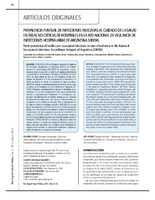Please use this identifier to cite or link to this item:
http://sgc.anlis.gob.ar/handle/123456789/189| Title: | Prevalencia puntual de infecciones asociadas al cuidado de la salud en áreas no críticas de hospitales en la Red Nacional de Vigilancia de Infecciones Hostpitalarias de Argentina (VIHDA) | Other Titles: | Point prevalence of health care associated infections in non critical areas in the National Nosocomial Infections Surveillance Network of Argentina (VIHDA) | Authors: | Lossa, Guillermo R. Giordano Lerena, Roberto Arcidiácono, Diego Fernández, Laura Díaz, Carolina Peralta, Norma Cabral, María de los Ángeles Clemente, Mabel |
Keywords: | Infección Hospitalaria;Prevalencia;Argentina | Issue Date: | 2011 | Abstract: | INTRODUCTION: the National Nosocomial Infections Surveillance Argentina (VIHDA) National Epidemiology Institute (INE-ANLIS) has developed and implemented since 2004 a system for surveillance and permanent Health Care Associated Infections (HCAI) in critical areas with more than 120 hospitals of high complexity of Argentina. To complement the information, we designed a study of prevalence in non-critical areas. OBJECTIVE: evaluate the point prevalence of HCAI in non-critical areas of hospitals in the National Surveillance Network. METHOD: Seventy hospitals in 21 provinces voluntarily joined the study, and 61 of them completed all three stages (preparation, survey and evaluation). 571 professionals simultaneously relieved the medical records of 237 non-critical hospital units, with 5,891 beds and 3,088 patients who met the inclusion criteria. For the survey data was designed software. RESULTS: The overall prevalence rate of HCAI was 9% (215/2.394) in adult patients and 4.9% (34/694) in pediatric prevalence rates of surgical site infections were 9.1% (450/497) in adults and 3.5% (3/86) in children. 5.5% of adult patients and 4.2% of pediatric had a past infection during hospitalization. CONCLUSIONS: We observed the use of open urinary systems and mechanical ventilation in non-critical areas, a situation that differs from that reported in the literature. We propose to take intervention measures aimed at improving the quality of care and patient safety. |
Description: | Fil: Lossa, Guillermo R. ANLIS Dr.C.G.Malbrán. Instituto Nacional de Epidemiología.; Argentina. Fil: Giordano Lerena, Roberto. ANLIS Dr.C.G.Malbrán. Instituto Nacional de Epidemiología.; Argentina. Fil: Arcidiácono, Diego. ANLIS Dr.C.G.Malbrán. Instituto Nacional de Epidemiología.; Argentina. Fil: Fernández, Laura. ANLIS Dr.C.G.Malbrán. Instituto Nacional de Epidemiología.; Argentina. Fil: Díaz, Carolina. ANLIS Dr.C.G.Malbrán. Instituto Nacional de Epidemiología.; Argentina. Fil: Peralta, Norma. ANLIS Dr.C.G.Malbrán. Instituto Nacional de Epidemiología.; Argentina. Fil: Cabral, María de los Ángeles. ANLIS Dr.C.G.Malbrán. Instituto Nacional de Epidemiología.; Argentina. Fil: Clemente, Mabel. ANLIS Dr.C.G.Malbrán. Instituto Nacional de Epidemiología.; Argentina. |
URI: | http://sgc.anlis.gob.ar/handle/123456789/189 http://msal.gov.ar/rasp/rasp/articulos/volumen6/prevalencia.pdf |
ISSN: | 1852-8724 | Rights: | info:eu-repo/semantics/openAccess Creative Commons Attribution 4.0 International License |
| Appears in Collections: | snrd Publicaciones INE |
Files in This Item:
| File | Description | Size | Format | |
|---|---|---|---|---|
| RevistaArgentinadeSaludPública,2011,2(6),12–18..pdf | Artículo en español | 178.02 kB | Adobe PDF |  View/Open |
Page view(s)
390
checked on Dec 17, 2025
Download(s)
141
checked on Dec 17, 2025
Google ScholarTM
Check
This item is licensed under a Creative Commons License


